|
|
 |
|
Calanoida ( Order ) |
|
|
|
Arietelloidea ( Superfamily ) |
|
|
|
Arietellidae ( Family ) |
|
|
|
Paramisophria ( Genus ) |
|
|
| |
Paramisophria giselae (Campaner, 1977) (F) | |
| | | | | | | Syn.: | Parapseudocyclops giselae Campaner, 1977 (p.812, figs.F); 1984 (p.106, fig.F); Björnberg & al., 1981 (p.654) | | | | Ref.: | | | Ohtsuka & al., 1991 (p.801, Rem.); Ohtsuka & al., 1994 (p.135,158, 161, Rem.F, figs.F); Bradford-Grieve & al., 1999 (p.882, 937, figs.F) | 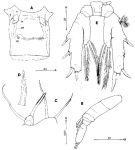 issued from : S. Ohtsuka, G.A. Boxshall & H.S.J. Roe in Bull. nat. Hist. Lond. (Zool.), 1994, 60 (2). [p.137, Fig.20, A-E]. Female (from Brazil, in coll. Univ. Sao Paulo)): A, genital double-somite (ventral); B, exopod of A2; C, 1st and 2nd praecoxal endites of Mx2; D, basal spine of Mx2; E, P5 (anterior). cd = copulatory duct; cp = copulatory pore; g = gonopore; rd = receptacle duct; o, oviduct; s, spermatothore remnant; sr = seminal receptacle. Nota: Posterior lateral corners of 2nd and 3rd pedigerous somites asymmetrically produced (corners more sharply pointed on right side than on left. Genital double-somite longer than wide, copulatory pore relatively thick, located on right side, seminal receptacle located near gonopore. A2 with indistinctly 9-segmented, terminal segment with 2 long plumose setae and vestigial seta. Md: mandibular gnathobase with small tuft of setules medially, 3 teeth on cutting edge, dorsalmost of which bifurcate at tip (originally drawn as monocuspid by Campaner, 1977); palp endopod rudimentary, 1-segmented, with 2 setae of unequal lengths; seta on 1st exopod segment not reduced, outer seta on 5th segment relatively long. Mx1 with relatively long seta on coxal endite; praecoxal arthrite with 5 naked spines and 1 process; coxal epipodite with 8 setae; small basal seta present; endopod bulbous, 1-segmented with 3 setae of unequal lengths. Mx2 with 1st praecoxal endite with 2 spinulose setae and rudimentary element, 2nd with 2 spinulose setae; basal spine naked. Mxp with the 1st to 6th endopodal segments bearing 1, 4, 4, 3, 3 and 4 setae, respectivelyP5 with coxae and intercoxal sclerite separate; endopod fused to basis; exopod almost fused to basis (fine suture visible); 1st and 2nd exopod segments fused with suture visible on posterior surface, 2nd and 3 rd exopod segments fused. Scales in mm.
|
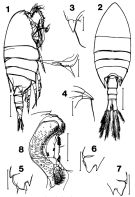 issued from : A.F. Campaner in Ciência e Cultura, 1977, 29 (7). [p.813, Figs.1-8]. As Parapseudocyclops giselae. Female (from continental shelf, Brazil): 1, habitus (lateral right side; 2, idem (dorsal); 3, rostrum (dorsal view): 4, idem (right lateral view); 5, left postero-lateral borders of last thoracic segments (lateral left side, holotype) ; 6, idem (left side, paratype); 7, idem (right side, paratype); 8, labrum (right ventral view). Scale bars: 0.500 mm (1, 2, 5, 6, 7); 0.100 mm (8 and detail in fig.1); 0.050 mm (3-4).
|
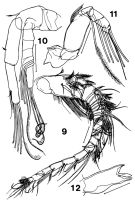 issued from : A.F. Campaner in Ciência e Cultura, 1977, 29 (7). [p.814, Figs.9-12]. As Parapseudocyclops giselae. Female: 9, left A1; 10, A2; 11, Md (mandibular palp); 12, Md (gnathobase). Scale bars: 0.100 mm.
|
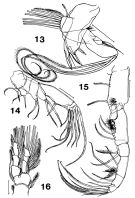 issued from : A.F. Campaner in Ciência e Cultura, 1977, 29 (7). [p.815, Figs.13-16]. As Parapseudocyclops giselae. Female: 13, Mx1; 14, Mx2; 15, Mxp; 16, P1. Scale bars: 0.100 mm.
|
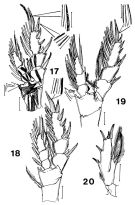 issued from : A.F. Campaner in Ciência e Cultura, 1977, 29 (7). [p.816, Figs.17-20]. As Parapseudocyclops giselae. Female: 17, P2; 18, P3; 19, P4; 20, P5. Scale bars: 0.1 mm; 0.050 mm (detais in figs 17-19).
|
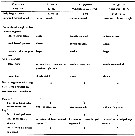 Issued from : G. Lian & H. Qian in Acta Oceanol. Sinica, 1994, 13 (4). [p.554, Table 1]. Morphological characteristics of female from P. sinica, P. japonica and P. giselae.
| | | | | NZ: | 1 | | |
|
Distribution map of Paramisophria giselae by geographical zones
|
| | | | Loc: | | | Brazil (Cabo Frio, continental shelf) | | | | N: | 1 | | | | Lg.: | | | (296) F: 2,6; 2,55; {F: 2,55-2,60} | | | | Rem.: | hyperbenthic.
See remarks of reexamination of the holotype and paratype by Ohtsuka & al. (1994, p.136) and comments. | | | Last update : 27/01/2015 | |
|
|
 Any use of this site for a publication will be mentioned with the following reference : Any use of this site for a publication will be mentioned with the following reference :
Razouls C., Desreumaux N., Kouwenberg J. and de Bovée F., 2005-2025. - Biodiversity of Marine Planktonic Copepods (morphology, geographical distribution and biological data). Sorbonne University, CNRS. Available at http://copepodes.obs-banyuls.fr/en [Accessed December 26, 2025] © copyright 2005-2025 Sorbonne University, CNRS
|
|
 |
 |









